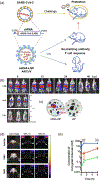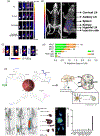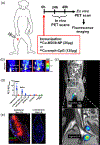Multimodality imaging of nanoparticle-based vaccines: Shedding light on immunology
- PMID: 35501142
- PMCID: PMC9481661
- DOI: 10.1002/wnan.1807
Multimodality imaging of nanoparticle-based vaccines: Shedding light on immunology
Abstract
In recent years, there have been significant innovations in the development of nanoparticle-based vaccines and vaccine delivery systems. For the purposes of both design and evaluation, these nanovaccines are imaged using the wealth of understanding established around medical imaging of nanomaterials. An important insight to the advancement of the field of nanovaccines can be given by an analysis of the design rationale of an imaging platform, as well as the significance of the information provided by imaging. Nanovaccine imaging strategies can be categorized by the imaging modality leveraged, but it is also worth understanding the superiority or convenience of a given modality over others in a given context of a particular nanovaccine. The most important imaging modalities in this endeavor are optical imaging including near-infrared fluorescence imaging (NIRF), emission tomography methods such as positron emission tomography (PET) and single photon emission computed tomography (SPECT) with or without computed tomography (CT) or magnetic resonance (MR), the emerging magnetic particle imaging (MPI), and finally, multimodal applications of imaging which include molecular imaging with magnetic resonance imaging (MRI) and photoacoustic (PA) imaging. One finds that each of these modalities has strengths and weaknesses, but optical and PET imaging tend, in this context, to be currently the most accessible, convenient, and informative modalities. Nevertheless, an important principle is that there is not a one-size-fits-all solution, and that the specific nanovaccine in question must be compatible with a particular imaging modality. This article is categorized under: Nanotechnology Approaches to Biology > Nanoscale Systems in Biology Therapeutic Approaches and Drug Discovery > Nanomedicine for Oncologic Disease Therapeutic Approaches and Drug Discovery > Nanomedicine for Infectious Disease.
Keywords: fluorescence imaging; medical imaging; nanomaterials; positron emission tomography; vaccines.
© 2022 Wiley Periodicals LLC.
Conflict of interest statement
CONFLICT OF INTEREST
Weibo Cai is a scientific advisor, stockholder, and grantee of Focus-X Therapeutics, Inc. All other authors declare that they have no conflict of interest.
Figures







Similar articles
-
Multimodality Imaging Agents with PET as the Fundamental Pillar.Angew Chem Int Ed Engl. 2019 Feb 25;58(9):2570-2579. doi: 10.1002/anie.201806853. Epub 2018 Dec 11. Angew Chem Int Ed Engl. 2019. PMID: 29968300 Free PMC article. Review.
-
Advanced Methods for Radiolabeling Multimodality Nanomedicines for SPECT/MRI and PET/MRI.J Nucl Med. 2018 Mar;59(3):382-389. doi: 10.2967/jnumed.116.187419. Epub 2017 Oct 12. J Nucl Med. 2018. PMID: 29025988 Review.
-
Exploring innovative strides in radiolabeled nanoparticle progress for multimodality cancer imaging and theranostic applications.Cancer Imaging. 2024 Sep 20;24(1):127. doi: 10.1186/s40644-024-00762-z. Cancer Imaging. 2024. PMID: 39304961 Free PMC article. Review.
-
Recent developments in multimodality fluorescence imaging probes.Acta Pharm Sin B. 2018 May;8(3):320-338. doi: 10.1016/j.apsb.2018.03.010. Epub 2018 Mar 30. Acta Pharm Sin B. 2018. PMID: 29881672 Free PMC article. Review.
-
An overview of nanoscale radionuclides and radiolabeled nanomaterials commonly used for nuclear molecular imaging and therapeutic functions.J Biomed Mater Res A. 2019 Jan;107(1):251-285. doi: 10.1002/jbm.a.36550. Epub 2018 Oct 25. J Biomed Mater Res A. 2019. PMID: 30358098 Review.
Cited by
-
Implications of hydrogen sulfide in colorectal cancer: Mechanistic insights and diagnostic and therapeutic strategies.Redox Biol. 2023 Feb;59:102601. doi: 10.1016/j.redox.2023.102601. Epub 2023 Jan 7. Redox Biol. 2023. PMID: 36630819 Free PMC article. Review.
References
-
- Binnewies M, Roberts EW, Kersten K, Chan V, Fearon DF, Merad M, Coussens LM, Gabrilovich DI, Ostrand-Rosenberg S, Hedrick CC, Vonderheide RH, Pittet MJ, Jain RK, Zou W, Howcroft TK, Woodhouse EC, Weinberg RA, & Krummel MF (2018). Understanding the tumor immune microenvironment (TIME) for effective therapy. Nature Medicine, 24(5), 541–550. 10.1038/s41591-018-0014-x - DOI - PMC - PubMed
Publication types
MeSH terms
Substances
Grants and funding
LinkOut - more resources
Full Text Sources
Medical

